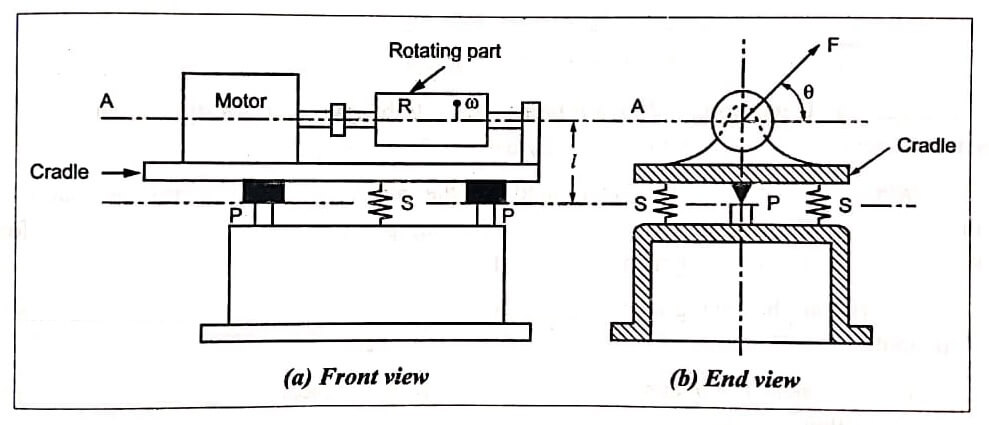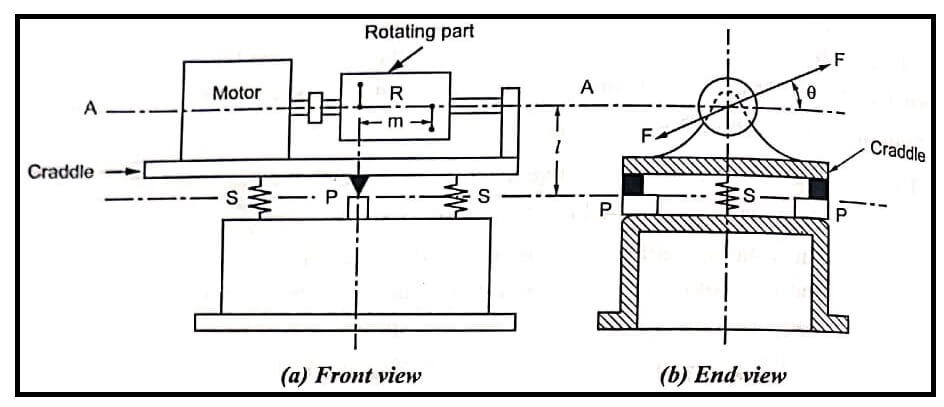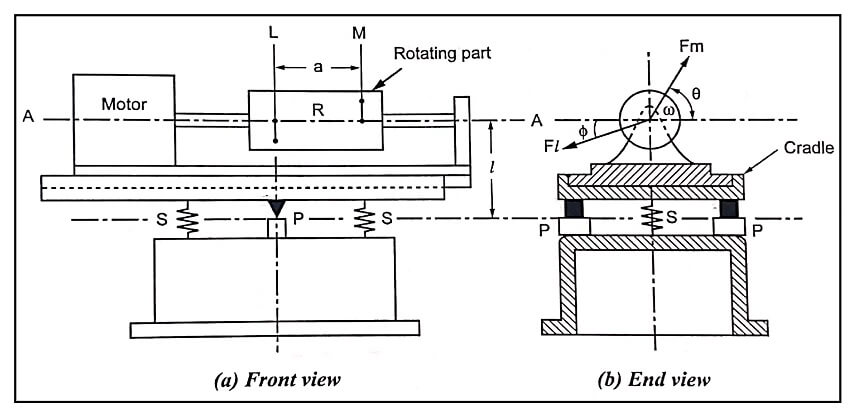Balancing machines are used to:
- Determine whether the rotating parts of a machine is completely balanced or not,
- Check the static dynamic balancing of rotating parts,
- Determine the next extent to which balancing is done (in case of unbalanced system).
Type of Balancing Machines
Three types of balancing machines are:
- Static balancing machines
These machines measure the static unbalance only. - Dynamic balancing machines
These machines measure the dynamic unbalance only. - Universal balancing machines
These machines are capable of measuring both static and dynamic unbalance.
Static Balancing Machines
The two types of static balancing machines – type I and II are described below.
Type-I Static Balancing Machine
A very simple static balancing machine is shown in Fig. Its working is very similar to the direct weighing machines.
Arrangement: The rotating part (R) to the balanced is mounted on a mandrel and then placed on one end of arm of the weighing machine, as shown in Fig. On the other end of the arm, a dead weight W is placed in order to bring the arm horizontal.

Working: The mandrel is rotated slowly either by hand or by an electric motor. If the rotating parts are out-of-balance, the beam (or arm) will move up and down. Due to this up ands down movement of the beam, the indicator pointer (I) will move across the scale. (Scale is calibrated in kg-cm or other convenient units). Obviously, if the body is in static balance, the indicator pointer (I) will remain stationary as the mandrel is rotated.
Type-II Static Balancing Machine
This type-II machine is more sensitive machine than the above discussed type-I machine.
Arrangement: The arrangement of type-II static balancing machine is shown in Fig (a). The rotating part (R) to be balanced is flexibly coupled to the motor. Both rotating part and the motor are placed on a cradle as shown in end view of the Fig. The cradle is supported by two pivots P-P and two springs S-S in such a manner that even a small out-of-balance static force will produce large oscillations or vibrations of the cradle.

Working: The rotating part is rotated by the motor. If the rotating parts is out-of-balance, then the out-of-balance static force will produce large oscillations or vibrations of the cradle. Obviously, if the body is in static balance (may or may not be dynamically balanced), there will be no oscillations of the cradle.
Dynamic Balancing Machines
This machine is used to measure the dynamic unbalance only.
[sc_fs_faq html=”true” headline=”h2″ img=”” question=”What is dynamic balancing?” img_alt=”” css_class=””] A system of rotating masses is in dynamic balance when there does not exist any resultant centrifugal forces as well as resultant couple. [/sc_fs_faq]
Arrangement: A dynamic balancing machine is shown in Fig. It may be observed that there is no difference in this machine and that of type-II static balancing machine, except that the positions of the pivots and the springs are interchanged. In static balancing machine the axis of the pivots P-P are parallel to the axis of rotation A-A whereas in dynamic balancing the axis of the pivots P-P are perpendicular to the axis of rotation A-A, as shown in Fig.

Prerequisite Condition: Before a rotating part is to be measured for dynamic unbalance, it is necessary that it should first be statically balanced.
Working: The rotating part is rotated by the motor. If there is any oscillations or vibrations of cradle, then it is known that the rotating part has out-of-balance dynamic force. Obviously if the body is in dynamic balance, there will be no oscillations of the cradle.
In the dynamic balancing machine, the dynamic couple F×m may be resolved into two components:
- Component F×m cos θ acting in the horizontal plane. It has no effect on the cradle oscillations; and
- Component F×m sin θ acting in the vertical plane. It causes forced vibration of the cradle.
Universal Balancing Machine
This machine measures both static and dynamic unbalance of rotating parts. This machine is similar to the dynamic balance machine except that in this no preliminary static balancing of the machine part is required.
Arrangement: A simple universal balancing machine is shown in Fig.
Working: It works on the principle that a given system of revolving masses can be balanced by introducing two balancing masses in arbitrarily chosen planes of rotation. First two planes say L and M are selected. By using those planes, the balancing effects are to be measured and necessary corrections are applied.

The rotating part is now mounted on the cradle in such a manner that the axis of the pivots P-P lines on one of the chosen planes, say L, as shown in Fig (a). The purpose of doing this is that the out-of-balance effect in this plane M produces a moment (O2 a sin θ) in the plane of oscillation and rocks the cradle about the axis P-P. The maximum values of this moment Fm . a can be measured so that the amount of unbalance wm × r in plane M may be obtained. Thereafter the cradle is slided along the guide, so that axis of oscillation lies in plane M and the amount and angular position of the unbalance w1 × r in plane L are determined.
| Read More Topics |
| Electrical machine design |
| Types of measuring machines |
| Computer controlled CMM |






